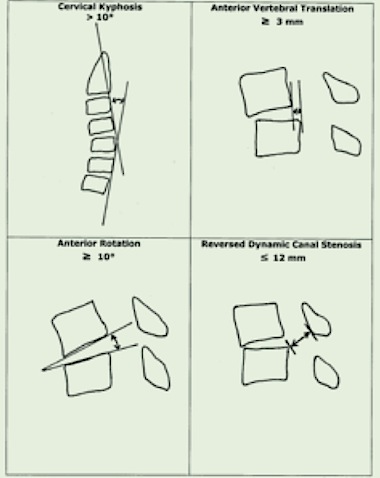Cervical Spine Kyphosis: Disc Degeneration and Spinal Cord Ischemia
 Friday, October 22, 2010 at 12:02AM
Friday, October 22, 2010 at 12:02AM


Dan Murphy, DC—
ICA Chiropractor of the Year 2009
INTRODUCTION
Since at least the 1970s, chiropractors have been taught that cervical spine kyphotic angulation is associated with a number of adverse effects, including:
- Chronic muscular contraction stress as a consequence of mechanically shifting the center of mass of the head forward, requiring muscle contraction as an effective counter balance. This is well described in the writings of rehabilitation specialists Rene Cailliet, MD.1
- The acceleration of degenerative disc disease. This is well described in the writings of radiologist Lee Hadley, MD,2 and orthopedic surgeon Ruth Jackson, MD.3
- Spinal cord tethering, ischemia and dysfunction, and possibly demyelinating disease. This is well described in the writings of neurosurgeon Alf Breig, MD.4
In this current article, I will review two recent studies that supports these teachings:
Kyphosis One Level Above the Cervical Disc Disease: Is the Kyphosis Cause or Effect?5
Key points from Ozer et al 20075 include:
- Reversal of the cervical lordotic curve into a cervical kyphosis “can be due to degenerative, inflammatory, traumatic or neoplastic conditions of the cervical spine.”
- Cervical spine kyphosis may be a factor in the development of cervical disc herniation and spondylosis.
- “With a loss of the normal sagittal alignment in kyphosis, the weight-bearing axis shifts anteriorly, and constant muscular contraction is required to maintain upright head posture. Eventually fatigue and pain occur, and the kyphosis progresses. The anterior shift of weight onto the vertebral bodies and degenerated discs results in a vicious cycle of disc degeneration and the formation of vertebral osteophytes. Thus, kyphotic sagittal alignment may provoke further degeneration at the adjacent segment. The increase in weight born by discs at lower level(s) may also cause the nucleus pulposus to herniate or degenerate. In the case of cervical disc disease associated with kyphosis at one level above, instability and kyphosis may perhaps be the initiating event, which later may act as a factor in the development of disc herniation and degeneration one level below.” These concepts of muscular contraction and developmental discogenic degeneration are consistent with the writings of Cailliet, Jackson, and Hadley.
- Uncorrected cervical spine kyphosis, especially if greater than 11°, can be associated with the following:
- Cervical disc disease.
- Progression of the kyphotic angulation.
- The spinal cord becomes draped and flattened over the posterior aspect of the vertebral bodies, diminishing the microvascular supply to the spinal cord.
- Adverse stretching or tethering of dentate ligaments and cervical roots.
- “Direct neuronal injury and myelopathy with progressive deformity may result from both spinal ischemia and increased spinal cord tension.” These concepts are consistent with the writings of Breig.
- Even mild cervical kyphosis may put the spinal cord at risk for histopathologic and vascular changes. “Maintaining normal cervical anatomy with its lordosis in this region of prominent movement may optimize the cord function.”
- In kyphosis, “radicular symptoms and findings may develop secondary to foraminal narrowing from uncovertebral and/or facet joint hypertrophy.”
- Kyphotic angulation one level above the level of cervical disc disease “may be a factor in the development of cervical disc herniation and spondylosis, rather than its result.”

Figure 1. Measurements of cervical spine segmental instability on the lateral cervical x-ray.
Cervical Spondylotic Myelopathy Associated with Kyphosis or Sagittal Sigmoid Alignment6
Key points from Uchida et al 20096 include:
- “The kyphotic deformity associated with cervical spondylosis is the result of progressive subluxation of the apophyseal joints due to degenerative changes in the facet joints and discs.”
- “In patients with kyphotic deformities, the spinal cord shifts to the anterior portion of the spinal canal and abuts the posterior aspect of the vertebral bodies at the apex of the deformity.”
- “Dynamic forces caused by segmental instability, which is often seen at the level of kyphosis particularly in cervical flexion movement, contribute to compromised cord function.”
- These factors are indicative of segmental instability, as determined by evaluation of the flexion lateral cervical radiograph:
- Segmental anterior vertebral translation ≥ 3 mm in the sagittal plane.
- Segmental anterior rotation ≥ 10° in the sagittal plane; this angle is constructed by the intersection of the lines drawn on the inferior and superior aspect of adjacent vertebral bodies.
- Reversed dynamic spinal canal stenosis of ≤ 12 mm on the flexion film; this is measured as the distance between the posterior superior edge of the vertebral body and the anterior edge of the lamina from the segment above, in the flexion position.
- “Loss of lordosis or kyphotic alignment of the cervical spine and spinal cord may contribute to the development of myelopathy, and in patients with cervical kyphotic deformity, the spinal cord could be compressed by tethering over the apical vertebra or intervertebral disc or by ossification of the posterior longitudinal ligament.”
- Longitudinal spinal cord distraction is a possible factor in progressive spinal cord dysfunction, and this issue is “often discussed clinically in the pathophysiology of tethered spinal cord syndrome.”
- Cervical flexion produces flattening of the small feeding vessels to the spinal cord. “If the kyphotic deformity continues, there may be progression of myelomalacia and spinal cord atrophy. Patients with long-standing kyphotic deformities are at risk for progression of myelopathy with resultant permanent damage to the spinal cord.”
- “We conclude that the sagittal kyphotic deformity related to flexion mechanical stress may be a significant factor in the development of cervical spondylotic myelopathy.”
SUMMARY
These articles emphasize the adverseness of cervical spine kyphosis: accelerated spondylosis, spinal cord tethering and myelopathy. In addition, kyphosis often has concomitant cervical spinal instability as contributing to the myelopathy, and we should check for spinal instability in all patients with cervical kyphosis of greater than 10°. The information presented herein, indicates that cervical spine kyphosis is often a serious clinical finding, especially if greater than 10° of angulation.
REFERENCES
- Cailliet R. Soft Tissue Pain and Disability, Davis, 1996.
- Hadley LA, Anatomico-Roentgenographic Studies of the Spine, fourth printing, Charles Thomas, 1979.
- Jackson R, The Cervical Syndrome, Thomas, 1978.
- Breig A, Adverse Mechanical Tension in the Central Nervous System: An Analysis of Cause and Effect. 1978. Almqvuist & Wiksell International, Stockholm, Sweden.
- Özer, Ercan MD; Yücesoy, Kemal MD; Yurtsever, Cem MD; Seçil, Mustafa MD; Kyphosis One Level Above the Cervical Disc Disease: Is the Kyphosis Cause or Effect? Journal of Spinal Disorders & Techniques 2007, Vol. 20, Issue 1, pp 14-19.
- Uchida K, Nakajima H, Sato R, Yayama T, Mwaka ES, Kobayashi K, Baba H. Cervical Spondylotic Myelopathy Associated with Kyphosis or Sagittal Sigmoid Alignment: Outcome after Anterior or Posterior Decompression; Journal of Neurosurgery: Spine 2009; Vol. 11, pp. 521-528.
 CBP Seminars | Comments Off |
CBP Seminars | Comments Off | 

